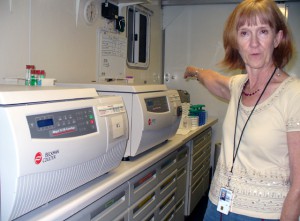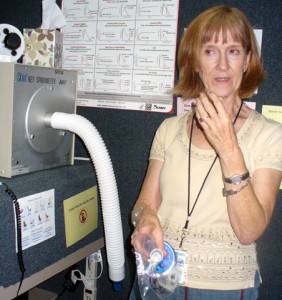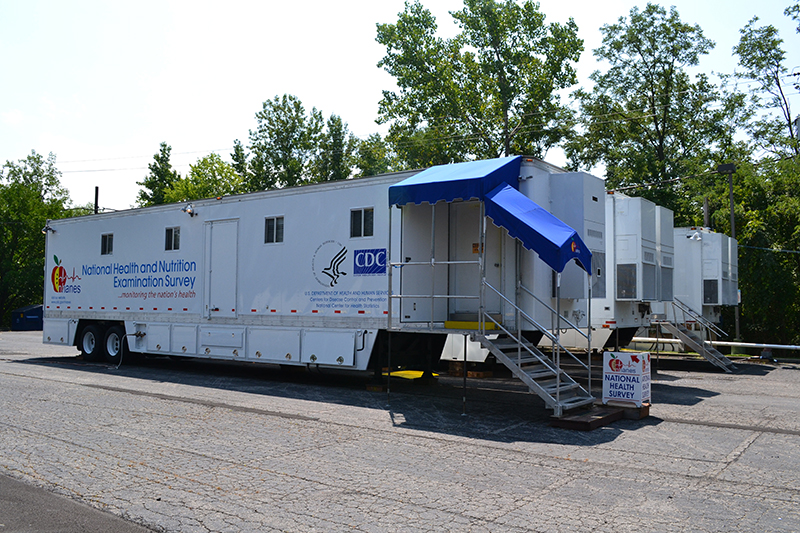NHANES’ MEC Collects Health Data
Posted on byFaye McDonald Smith
The Mobile Exam Center (MEC) is an important part of the National Health and Nutrition Examination Survey (NHANES), which, since 1999, is conducted annually to assess the health and nutritional status of adults and children in the United States. NHANES conducts interviews at the home and exams at the MEC. These data contribute to up-to-date statistics about the health status of the US population.
NHANES was created from The National Health Survey Act of 1956, which authorized a survey to provide current statistical data on the amount, distribution, and effects of illness and disability in the US. A part of CDC’s National Center for Health Statistics, the NHANES survey is unique in that it combines interviews and physical examinations. Over the years, NHANES has surveyed more than 140,000 people. Data conducted from the survey have led to important improvements in the health and diet of people in the US.
NHANES’ Mobile Exam Center, aka The MEC
Persons selected to participate in the NHANES survey are asked to come to a Mobile Exam Center (MEC) for a variety of physical tests and measurements. The MEC is configured from four connecting tractor trailers. A fifth unattached trailer was included in 2012 to administer exams exclusively for children, 3-15, for the NHANES National Youth Fitness Survey. The MEC is parked in a selected county for about six weeks, and is ideally in a convenient area that people know. NHANES Planning Branch Chief Vicki L. Burt, ScM, RN, says that NHANES often asks the local health department for suggested locations.
The MEC: Multiple Components and Custom-Made Pajamas
On a typical day, about 20 people come to the MEC for a reserved appointment. The NHANES exam consists of multiple tests and components, which for adults generally take about four hours. Participants change into specially designed socks and pajamas made of paper, and put on a bracelet that has a barcode which is their unique identifier.
Generally, the lab tests are a first priority, along with obtaining height, weight and other body measurements, because they are used for many analyses. However, there is no particular order in which the various components of the exam are administered. The staff makes a major effort to keep the wait time to a minimum. “We want every room to be used as much as possible and every staff person to be used as much as possible,” says Burt. “If you’re in a room getting your blood drawn, rather than have you come back to the waiting room afterwards, the coordinator might send you directly for a dental exam.”
However, certain components cannot be done until something else is completed. For instance, a female participant may not have a particular scan unless she has tested negatively for pregnancy.
Each two-year cycle of NHANES there are 12 to 14 different examination components. A few of the recent components are further described below.

Photo by Faye McDonald Smith
Assessing Muscle Strength and Physical Activity
One exam room tests for upper body muscle strength, and includes a component that involves follow-up by participants. Persons aged 3 and older receive a waterproof physical activity monitor that they are asked to wear on their arm 24 hours a day for a week. They receive a letter that explains what it is, in case they need documentation for school or airport security. The monitor measures the amount and intensity of movement, as well as sleep.
Participants who mail the monitor back in a pre-addressed envelope receive a check for $40, an attractive incentive that encourages about a 90 percent return. Once the data are removed, the monitors can be re-used several more times. The National Cancer Institute coordinates funding for the activity monitor and the grip strength components.
How’s Your Breathing?
The respiratory health exam consists of two breathing tests. One measures the amount of exhaled nitric oxide (a high level indicates inflammation in the lungs, such as asthma or other airway diseases). The other test, spirometry, determines any obstruction in the lungs by providing a baseline assessment of lung volume and rate of air flow. If people have chest obstruction, the rate of air flow is significantly slower than normal.
The National Heart, Lung, and Blood Institute (NHLBI) sponsored both breathing components of the respiratory exam. CDC’s National Institute for Occupational Safety and Health (NIOSH) provided technical training and quality control, and provided the spirometers used in the MECs—the same ones that were used in NHANES III from 1988-94.

Photo by Faye McDonald Smith
Dietary Recall—Exactly What Did You Eat?

Photo by Faye McDonald Smith
“We have 3-dimensional food models that are all a precise volume,” Burt continues. “If people say they’ve had mashed potatoes, we ask, ‘How much?’ Sometimes to help figure out how much they’ve eaten, they might put the amount of ‘food’ (represented by various sized bean bags) on a plate or in the same sized bowl they used at home. We basically go through what they ate five times, and each time we ask for more detail. It’s called the multiple pass method.” As a follow-up activity, participants are given a set of measuring cups and spoons and a ruler so when they go home they can more accurately report how much they have eaten.
Burt says that some participants make their food from recipes, so NHANES asks for those recipes to try to assess the amount of food consumed. On the other hand, some food servings are relatively easy to measure, such as common foods (lasagna) and common brands (McDonald’s Big Mac) that have standard measurement codes.
In 2002 NHANES collaborated with the US Department of Agriculture (USDA) to develop the current survey used for food intake for individuals. The USDA provides the software for the dietary recall (Automated Multiple Pass Method) that NHANES collects and evaluates the data.
The Mobile Exam Center Interview
Two rooms are set aside for the Mobile Exam Center interview, which, like the dietary recall, is one of the longest components of the exam. In addition to English and Spanish, the interview is offered in Korean, Vietnamese, and Chinese (Simplified, Traditional Cantonese, and Traditional Mandarin).
Questions range from a variety of topics related to the participant’s household, such as how much tobacco exposure they’ve had in the last five days, to personal questions related to sexual behavior and reproductive health. For people 60 and older, there is a section on cognitive function, where they are shown 10 words and asked to repeat them several minutes later.
At certain points an interviewer is present; at other times, particularly for sensitive questions, the participant is alone in the room. When alone, the interview is ACASI (Audio Computer-Assisted Self Interview).
As with many other components of the MEC, the ACASI has changed over the years. “We did a pubertal maturation exam in the HES III (1966-1970) and again in NHANES III (1988-1994) where doctors actually looked at children’s genitals and breasts to see how developed they were, and coded that,” explains Burt. “That’s become too sensitive in our day and age, so we developed a self-administered test where the children (ages 6-17) grade themselves. They’re shown medical drawings and pick what most looks like their genital development and breast development. There’s a mirror if they want to take a look while they’re in the room.”
Burt points out that all of the exam components have public health relevance. “Here, it’s important for reasons of nutrition and growth to have some idea where children are in puberty.”
Can You Name That Smell?
The taste and smell test is a relatively new exam component that started last year. Burt describes it as one of the most challenging tests to get on the survey and also one of the most speculative. “We don’t usually pilot test anything twice, but this was problematic,” she says.
The smell test is a forced answer test, whereby people scratch and sniff and then select a smell, such as soap, black pepper, leather, etc. What was “discovered” in the pilot tests is that some smells have sex bias. “Many men seem to have difficulty in naming floral or food-related smells,” states Burt. Consequently, some smells that were pilot tested were eliminated from the final survey if there was a large sex difference. Two smells—natural gas and smoke—are included because of their importance related to safety.
In terms of taste, one person’s assessment of “strong” might be quite different from someone else’s. To address this issue, NHANES developed a training method to use with the existing scale. A range of light intensities are shown to participants while explaining the scale. If the participant can rate the light intensities in the correct order of brightness, the taste test is completed.
Yes, There’s a Doctor in the House
In the physician’s room, participants have their blood pressure taken, notably, with a mercury manometer. Burt says that the switch to an automated monitor may likely come any time, though it might mean a change in the prevalence of hypertension because automated models do not give the same results as mercury, which is still considered the gold standard.
The physician may also counsel participants about any tests during the exam that are considered abnormal; make recommendations for follow-up exams; give referrals for serious medical issues; and evaluate participants for other exams.
The MEC also includes a dental exam and total body scan. Currently, the total body scan, which uses Dual Energy X-Ray Absorptiometry (DXA), is sponsored by NHLBI and the National Institute of Diabetes and Digestive and Kidney Diseases (NIDDK). In 2013 the CDC Foundation joined as a sponsor to measure bone density, last measured in 2009-10.
Participants leave the MEC with a report of many of the tests that were conducted throughout the day. A final report, which includes findings from the exam and blood tests, is mailed several weeks later. Sexual disease results are not mailed; a participant must call in with a password.
Especially Wanted: Older White Men
NHANES uses an area probability sample using the most current US census information to select participants. Each year 15 counties are randomly chosen, so virtually every county in the nation has some probability of being selected. Extremely rural or sparsely populated counties are clustered together.
NHANES divides the counties into neighborhoods that are selected at random, and then further divides those segments into housing units or households selected at random. “About four months before we come to town, we have people called ‘listers’ who write down every address that looks like a dwelling unit where somebody lives in the areas selected,” says Burt.
NHANES’ field interviewers ask residents a few questions to determine if anyone in their household is eligible for the study. Participants are selected based on age, sex, and racial/ethnic background. “On average, for every four households we go to, we don’t select anybody in about three,” explains Burt.
Each NHANES participant (also referred to as an SP for sample person) represents thousands of US residents. The identity of participants is strictly confidential, and of course, participation is voluntary. NHANES oversamples certain race and ethnic groups, such as Hispanic, African American, and Asian persons (depending on the NHANES survey years), to ensure there are enough people in the survey to estimate health and nutritional status in these subpopulations.
NHANES also oversamples people over 60 because a lot of illness occurs in older adults. And since the elderly have significantly more mortality, there are fewer people within that population to sample. Burt says that one of the rarest groups sampled are elderly white men. “Sometimes the interviewer goes to a house with the sampling direction: ‘Look for white men, 80 and older.’ If there’s not a white male 80 and older living there, no one is selected from that household.”
High Standards Even for the “Lowly” Cup
NHANES carefully researches, updates, and evaluates the various components of its exam, including the equipment and supplies used—from the most sophisticated medical machinery to the smallest of “low tech” items, such as the urine cup. Each Mobile Exam Center participant, aged 6 and older, is asked to give a urine specimen. A few years ago the urine cup was changed to a larger 500cc container. But a larger size was not the only criteria.
Explains NHANES Planning Chief Vicki Burt: “We need the cup to be sterile. We also need it to be free of certain trace elements such as lead, cadmium and mercury, for example, because we are testing for levels of these elements in the US population. So, we pre-screen the cups for these elements. The screening is done by the CDC/NCEH, Environmental Health Laboratory Sciences Laboratory, Inorganic and Radiation Analytical Toxicology Branch. The first cup we selected was found to have high levels of trace elements, so we had to find another one before it could be used on the survey.”
Posted on by



